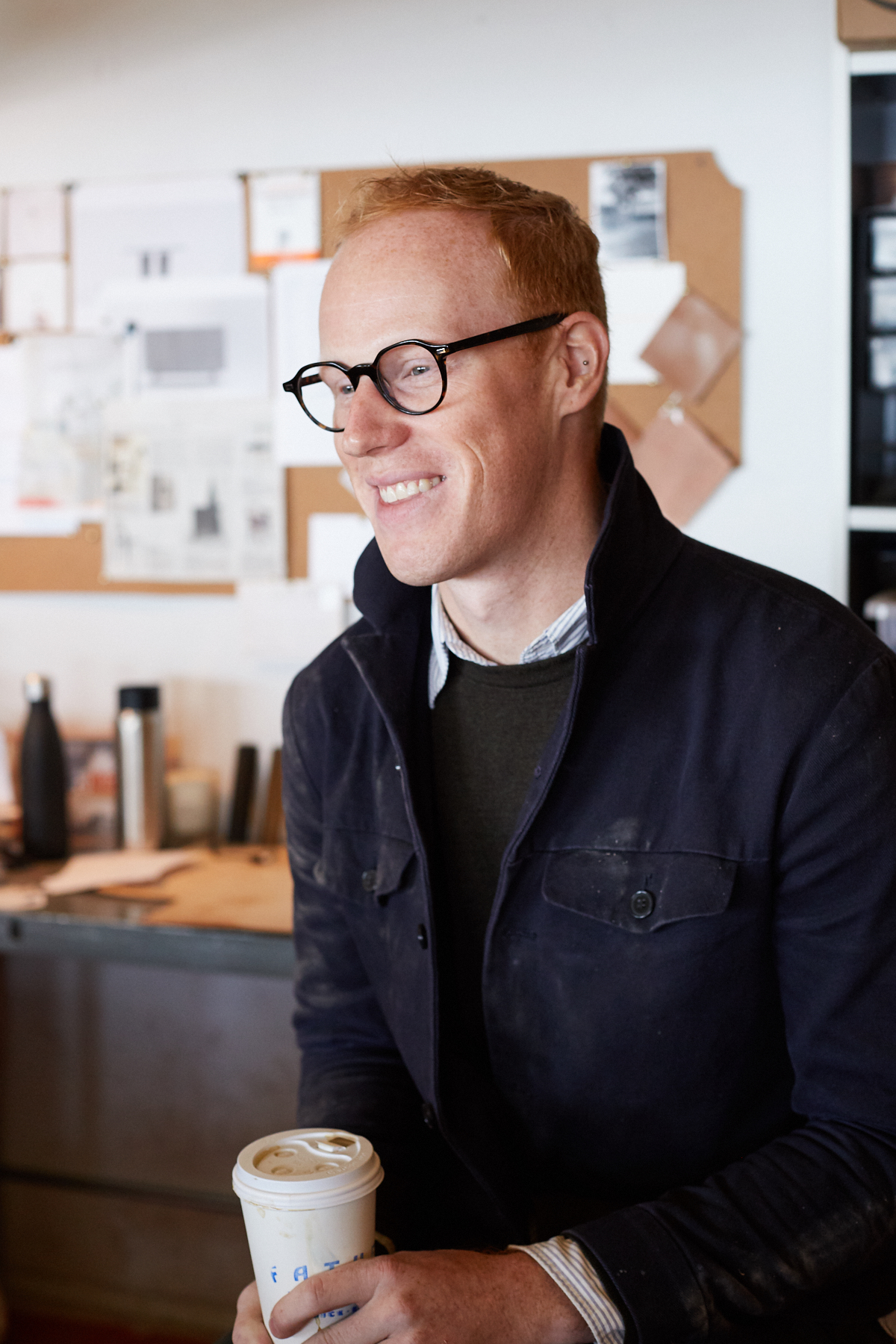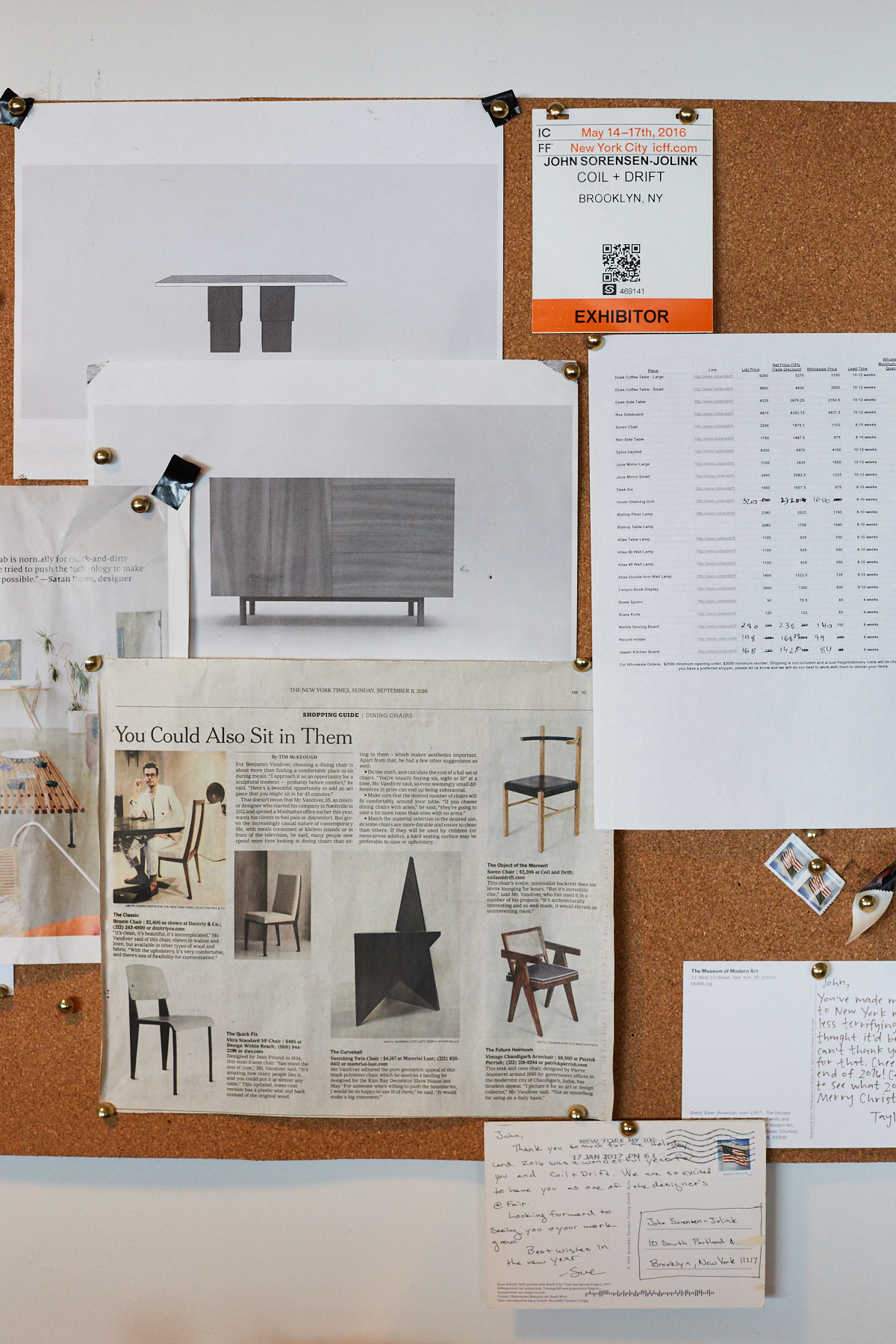I think my job is to make sure that the work is well designed to work in many spaces and is also well made so that it will last. You will have that piece of furniture in your home for as long as you want to have it
— John Sorensen-Jolink, Coil + Drift
Walking into the space where John Sorensen-Jolink spends his days is a little like wandering into the wings of a theater. Charismatic props hug the edges – a motorcycle hulking in one corner, a stack of surfboards rising up a far wall – while closer in, objects in work rehearse their movements on machinery, and completed pieces swaddled in blankets and brown paper await their moment in the limelight. But the metaphor is inspired mainly by Sorensen-Jolink himself, a lithe presence negotiating table corners and giant panels of wood with grace that belies his former occupation as a modern dancer, performing with the likes of Twyla Tharp and Robert Wilson. These days, as founder of Brooklyn-based studio Coil + Drift, he is choreographing a production all his own—one in which his artfully conceived furniture, lighting and tabletop pieces are taking center stage in the design world.
What led you to go from a successful performing career to founding your own design studio?
As a dancer, I performed a lot on the road and was often on tour for most of the year. I toured with one Broadway show, “Movin’ Out,” for a year and a half straight. The experience of living out of a suitcase and on the road gave me that urge to define my sense of home. I think I’ve always been interested in the spaces we live in and how we lay them out. I was constantly moving furniture around growing up, trying to find the perfect flow of the space. And I have strong memories of having these thoughts while I was on tour – how important certain things were, and how much I hated certain things. For example, a hook in a hotel bathroom is so necessary, how many you have and their placement, and I found it super surprising how terrible most hotel rooms were in terms of design and functionality.
Coming off the road from that, I started to transition into design. I guess I began designing because I was curious, after dancing, to have a practice that was less ethereal, creating physical objects as opposed to something that was gone after one evening.
Why furniture as opposed to, say, sculpture?
I was super interested in owning my own business and teaching myself how to do that. And that worked a lot better in my mind in terms of doing furniture. I really gravitated toward furniture because I had that urge to define my sense of home and create functional objects. Sculpture felt too close to dance, and interior design didn’t feel tangible enough either. That said, I’m very interested in spatial design as well. Coil + Drift will design spaces at some point, but I wanted to start by putting out a physical product because it’s a much more direct way of saying this is who I am, this is what I’m making.
You founded Coil + Drift in 2014. Just two years later, in May 2016, you won the prestigious ICFF Editors’ Award for Best New Designer. How did that impact things?
That fall, I felt a bit isolated. We won the award and things were really happening, and I wanted to engage with other furniture designers and figure out how to go to the next place. So I did what [my studio director] Taylor calls my listening tour, where over the course of three months I reached out to every New York-based designer I am really inspired by and said, can I come by and talk to you? It was super informative and eye-opening.
Who were those sources of inspiration?
I went to talk to the Egg Collective ladies—love them. They’re super inspiring from a design perspective but also in terms of their business model. Then I went and talked to Nick and Rachel at Calico Wallpaper. They’re in Red Hook so we discussed how they connect with potential clients while being based outside Manhattan. And I talked to the Apparatus guys. Gabriel [Hendifar] and I were in touch because he has our Soren Chairs in his office. Everything they do from object design to interior design is flawless, and they’ve grown very, very quickly, so it was really helpful in terms of new ideas and learning how they structure and run their business.
Anyone who says they just came onto the scene and effortlessly exploded in popularity is probably not telling the whole truth. You definitely need to talk to someone. This industry is about connections and networking and relationships with people. For example, I recently had a marble crisis with my fabricator and needed a new person to fabricate. Who am I supposed to call? The people who make really beautiful marble work. But if I didn’t have a relationship with them already, I wouldn’t feel comfortable calling. People talk about the design world as being super cutthroat but it’s so not. It’s super close, and there’s a lot of generosity.
Did you come out of your “listening tour” with any specific new ideas?
Multiple people encouraged me to design more lighting, and I realized there are a lot of good reasons to do lighting. We’re focusing a lot more on it now, and doing a lot of new lighting this year. For me, it’s a really clear way to express your perspective because people see lighting as sculptural, so they’re willing to step back and just look at it in a way they might not with a piece of furniture. Because with furniture, you expect to be on it, using it. My ultimate goal with furniture design is to get people to notice the piece while they’re using it – that would be really amazing.
Do you think a lot about how each Coil + Drift piece will ultimately be used?
The idea of existing with and living with the object very often comes to the forefront when I’m designing something. For example, this piece [the June Mirror] is very clearly morphing in its shape, depending on how you place it in your space and what’s around it and the orientation. I love that you can hang it horizontally or vertically. Most of the work I make ends up looking different from every angle, because I make things that usually are focused on volume and the way that people are around them.
What’s the aesthetic in your own home? Do you live with a lot of Coil + Drift pieces?
I definitely live with all the pieces for a period of time, so yes it’s filled with Coil + Drift, but it’s not a showroom. It’s very functional because, of course, I live in it, and I also have a husband who lives in it and has very strong opinions about objects. So it’s not a showroom. But that’s something I look forward to having in the future: a place where I can play with living environments and design a creative space that is all about how you experience the work. When I design, a character will develop in my mind, a person who lives with this particular piece – almost like the ideal of who would live with this and what’s their home like. So I imagine what that all looks like. It’s the job of the designer to show the world how they should live with this work.
How does your approach, as a small studio working with local fabricators, differ from that of a bigger manufacturer?
Everything is made to order, and we have a relationship with every client we work with that doesn’t stop when they get the piece. We’re constantly in touch with people we’ve already worked with before. It’s a very different, much more intimate experience than working with a larger company. It’s much more experiential and much more about a relationship with the person who actually created the piece. I think my job is to make sure that the work is well designed to work in many spaces and is also well made so that it will last. You will have that piece of furniture in your home for as long as you want to have it – and if something happens to it, just call us up and we can help. I really love the process of working directly with clients.
Can you take us through the journey of a favorite Coil + Drift piece?
One piece I really love that we make from start to finish here in the studio is the June Mirror. We use a CNC machine and choose wood that has irregularities, because I love the contrast between that perfect computerized control and the wood’s natural character. The CNC machine can’t do right corners, only curves, so there is a lot of hand work and hand sanding, and it takes up to four days from start to finish.
What’s inspiring you at the moment?
I’ve become super interested in modern design from the 1960’s and 70’s, designers like Gaetano Pesce and Marcel Breuer. You can see that in the June Mirror, for example. I’ve also been pushing myself on my relationship to color, which I realized was safer than I thought it was. I wasn’t taking many risks when it came to color. A neutral piece will work in a lot of places, but it’s also missing some opportunities to really use color in beautiful ways. The Sylvia Daybed is a great example. We originally upholstered it in a woven linen that was black and white, and now we’ve reupholstered it so the cushion is a sort of green-tinted off-grey color, with a rust-colored suede bolster. It works really beautifully with the white oak that we’re using for the new collection. So just bringing some colors in — but you won’t start seeing Memphis Group on my inspiration list. Although I really respect it, I’m drawn to colors that aren’t as bright and simple as Memphis.




































